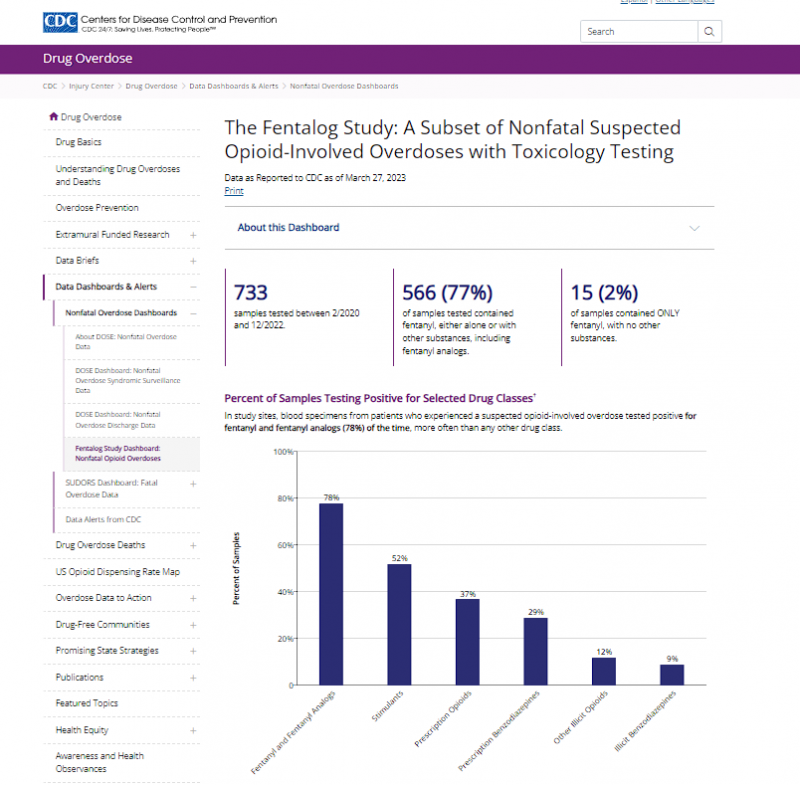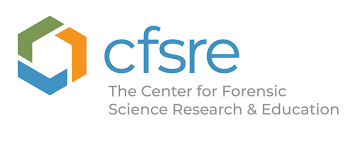
Fentanyl Analog (Fentalog) Study
About the Project
Fentanyl and its analogs (fentalogs) are increasingly contributing to opioid overdoses and deaths across the United States. Between 2016 and 2017, opioid overdoses made up 27.5% of opioid related visits captured in the National Emergency Department Sample (NEDS) database.1 The CDC has estimated that nearly 75% of drug overdose deaths were opioid related in 2020.2 With increased opioid use and the changes in opioid prescribing patterns, there has been an upswing of illicit synthetic opioids such as fentanyl and fentanyl analogs, also known as “fentalogs.”
To investigate this increased fentalog epidemic, ToxIC partnered with the Icahn School of Medicine on a 5-year R01 grant from the National Institute on Drug Abuse (NIDA). The project, entitled “Predicting Medical Consequences of Novel Fentanyl Analog Overdose Using the Toxicology Investigators Consortium (ToxIC)” utilizes high volume geographically diverse ToxIC sites to evaluate risk factors and characterize novel synthetic opioids.
This multicenter, prospective cohort study enrolls consecutive patients with suspected opioid overdose who present to a participating emergency department between 2020-2025. The ten participating sites around the country in this project are a subset of the Toxicology Investigators Consortium (ToxIC) site network.
1 Langabeer JR, Stotts AL, Bobrow BJ, et al. Prevalence and charges of opioid-related visits to U.S. emergency departments. Drug Alcohol Depend 2021;221:108568.
2 Understanding the Opioid Epidemic. Centers for Disease Control and Prevention. https://www.cdc.gov/opioids/basics/epidemic.html. Accessed August 3, 2023.

Principal Investigator:
Alex Manini, MD, MS, FACMT
Icahn School of Medicine
New York, NY

Co-Investigator:
Jeffrey Brent, MD, FACMT
University of Colorado School of Medicine
Aurora, CO

Co-Investigator:
Paul Wax, MD, FACMT
Executive Director,
American College of
Medical Toxicology
Publications from the Fentalog Project
2024
1. Amaducci A, Culbreth R, Wax P, Aldy K, Brent J, Campleman S, Li S, Krotulski AK, Love J, Manini AF; On Behalf of the ToxIC Fentalog Study Group. Is Chronic Pain Associated With Fentanyl or Fentanyl-Analog Overdoses in ED Patients? J Med Toxicol 2024; 20:91. View Abstract
2. Carpenter J, Culbreth R, Wax P, Aldy K, Brent J, Campleman S, Li S, Shastry S, Berger J, Manini A; On Behalf of the ToxIC Fentalog Study Group. Buprenorphine and Naloxone Prescribing After Opioid Overdose: A Report From Ten Academic Hospital Systems. J Med Toxicol 2024; 20:78-79. View Abstract
3. Culbreth C, Aldy K, Krotulski A, Brent J, Campleman S, Li S, Abston S, Logan B, Wax P, Amaducci A, Judge B, Levine M, Calello D, Shulman J, Schwarz E, Carpenter J, Buchanan J, Manini A; On behalf of the ToxIC Fentalog Study Group. Oxycodone overdose is associated with the intention to self-harm among emergency department patients. Clin Toxicol (Phila). 2024;62(1)98. View Abstract
4. Hughes A, Culbreth R, Aldy K, Brent J, Wax P, Krotulski A, Li S, Campleman S, Logan B, Manini A; On Behalf of the ToxIC Fentalog Study Group. Clinical Correlates of Confirmed Benzodiazepine and Opioid Co-Exposures Among Patients Presenting to the Emergency Department. J Med Toxicol 2024; 20:26-27. View Abstract
5. Hughes A, Culbreth R, Aldy K, Krotulski A, Brent J, Campleman S, Li S, Abston S, Logan B, Wax P, Amaducci A, Judge B, Levine M, Calello D, Shulman J, Schwarz E, Carpenter J, Buchanan J, Manini A; On behalf of the ToxIC Fentalog Study Group. Additional morbidity of co- exposure to novel psychoactive benzodiazepines in Emergency Department patients with confirmed opioid overdose. Clin Toxicol (Phila). 2024;62(1)28. View Abstract
6. Schwarz ES, Culbreth R, Buchanan J, Aldy K, Brent J, Wax P, Levine M, Suarez F, Kumar A, Manini A; On Behalf of the ToxIC Fentalog Study Group. Precipitated Withdrawal in Emergency Department Patients Following a Presumed Opioid Overdose. J Med Toxicol 2024; 20:36-37. View Abstract
7. Spungen HH, Culbreth R, Aldy K, Brent J, Wax P, Krotulski AK, Li S, Campleman S, Logan B, Abston S; On Behalf of the ToxIC Fentalog Study Group. Geographic Variability of Novel Potent Opioids and Associated Emerging Substances Detected in Emergency Department Patients. J Med Toxicol 2024; 20:78. View Abstract
8. Suarez F, Massengill D, Buchanan J, Kumar A, Culbreth R, Aldy K, Brent J, Wax P, Campleman S, Manini AF; On Behalf of the ToxIC Fentalog Study Group. Opioid Drug Concealment and Treatment Requirements in ED Patients With Confirmed Opioid Overdose. J Med Toxicol 2024; 20:77-78. View Abstract
9. Sutphin A, Falise A, Aldy K, Culbreth, Brent J, Kumar A, Buchanan J, Campleman S, Krotulski A, Wax P, Manini A; On behalf of the ToxIC Fentalog Study Group. Mechanical ventilation requirements in emergency departments patients with confirmed opioid overdose. Clin Toxicol(Phila). 2024;62:21. View Abstract
2023
1. Aldy K, Wax P, Culbreth R, Krotulski A, Brent J, Campleman S, Logan B, Meyn A, Manini A, On behalf of the Toxicology Investigators Consortium Fentalog Study Group. The Prevalence of Novel Psychoactive Substances in Opioid Overdose Patients. J Med Toxicol. 2023;19(2):63-168. View Abstract
2. Aldy, K, Culbreth R, Love J, Wax P, Campleman S, Brent J, Krotulski A, Levine M, Buchanan J, Manini A; On Behalf of the ToxIC Fentalog Study Group. Clinical and demographic correlates of confirmed xylazine and levamisole exposure among ED patients with acute fentanyl overdose. Clin Toxicol (Phila). 2023;61:4-5. View Abstract
3. Campleman S, Li S, Aldy K, Culbreth R, Krotulski A, Schwarz E, Brent J, Wax P, Manini A, On behalf of the ToxIC Fentalog Study Group. Prevalence of Laboratory Confirmed Hallucinogens within an Emergency Department-Derived Opioid Overdose Cohort. J Med Toxicol. 2023;19(2):63-168. View Abstract
4. Culbreth R, Aldy K, Wax P, Krotulski A, Brent J, Campleman, Logan B, Li S, Manini A, On behalf of the Toxicology Investigators Consortium Fentalog Study Group. Geographical Differences in Opioid, Stimulant, and Benzodiazepine Use Among Suspected Opioid Overdoses Presenting to the Emergency Department. J Med Toxicol. 2023;19(2):63-168. View Abstract
5. Culbreth R, Aldy K, Wax P, Campleman S, Brent J, Krotulski A, Li S, Abston S, Logan B, Manini A; On Behalf of the ToxIC Fentalog Study Group. Confirmed drug exposures in ED patients presenting after opioid overdose with selfharm intent. Clin Toxicol (Phila). 2023;61:89. View Abstract
6. Goodrich W, Wax P, Aldy K, Culbreth R, Krotulski A, Brent J, Campleman S, Logan B, Amaducci A, Manini A, On behalf of the ToxIC Fentalog Study Group. Levamisole: A Classic Adulterant with a Novel Association. J Med Toxicol. 2023;19(2):63-168. View Abstract
7. Hughes A, Culbreth R, Aldy K, Li S, Campleman S, Logan B, Brent J, Krotulski A, Wax P, Manini A; On Behalf of the ToxIC Fentalog Study Group. Benzodiazepine co-exposure among patients treated in the emergency department with suspected opioid overdose. Clin Toxicol (Phila). 2023;61:42. View Abstract
8. Love J, Culbreth R, Aldy K, Wax P, Campleman S, Brent J, Krotulski A, Li S, Logan B, Manini A; On Behalf of the ToxIC Fentalog Study Group. Predictors of xylazine positivity in emergency department patients with opioid overdose. Clin Toxicol (Phila). 2023;61:4. View Abstract
9. Levine M, Culbreth R, Buchanan J, Schwarz E, Aldy K, Campleman S, Krotulksi A, Brent J, Wax P, Manini A; On Behalf of the ToxIC Fentalog Study Group. Use of naloxone upon discharge. Clin Toxicol (Phila). 2023;61:29. View Abstract
10. Levine M, Culbreth R, Buchanan J, Schwarz E, Aldy K, Campleman S, Krotulksi A, Brent J, Wax P, Manini A; On Behalf of the ToxIC Fentalog Study Group. Xylazine trends over time. Clin Toxicol (Phila). 2023;61:28. View Abstract
11. Levine M, Culbreth R, Buchanan J, Schwarz E, Aldy K, Campleman S, Krotulski A, Brent J, Wax P; On Behalf of the ToxIC Fentalog Study Group.. Prevalence of HIV among patients presenting with acute opioid toxicity. Clin Toxicol (Phila). 2023;61:28-29. View Abstract
12. Love J, Culbreth R, Aldy K, Wax P, Campleman S, Brent J, Krotulski A, Li S, Logan B, Manini A; On Behalf of the ToxIC Fentalog Study Group. Predictors of xylazine positivity in emergency department patients with opioid overdose. Clin Toxicol (Phila). 2023;61:4. View Abstract
13. Love J, Culbreth R, Aldy K, Kaplan S, Wax P, Campleman S, Brent J, Krotulski A, Li S, Logan B, Manini A; On Behalf of the ToxIC Fentalog Study Group. Differences in naloxone dosing by gender in emergency department opioid overdose: results of a multicenter study. Clin Toxicol (Phila). 2023;61:44-45. View Abstract
14. Renny MH, Aldy K, Brent J, Wax P, Krtolski A, Campleman S, Logan B, Calello D, Culbreth R, Manini A, On behalf of the ToxIC Fentalog Study Group. Young Adults With Acute Opioid Overdose: What Substances Are Actually Involved? J Med Toxicol. 2023;19(2):63-168. View Abstract
15. Renny M, Aldy K, Brent J, Wax P, Krotulski A, Campleman S, Calello D, Culbreth R, Manini A; On Behalf of the Toxicology Investigators Consortium (ToxIC) Fentalog Study Group. Young Adults With Acute Opioid Overdose: What Substances Are Actually Involved? Pediatric Academic Societies. 2023;E-PASS 5555.543
16. Shastry S, Aldy K, Brent J, Wax P, Krotulski A, Logan B, Campleman S, Culbreth R, Manini A, On behalf of the Toxicology Investigators Consortium Fentalog Study Group. Heroin or Fentanyl: Prevalence of Confirmed Fentanyl in ED Patients with Suspected Heroin Overdose. J Med Toxicol. 2023;19(2):63-168. View Abstract
17. Wax P, Culbreth R, Brent J, Aldy K, Krotulski A, Campleman S, Logan B, Abston S, Manini A, On behalf of the ToxIC Fentalog Study Group. Yearly Trends and Regional Patterns of Novel Psychoactive Substances in Opioid Overdose Patients. J Med Toxicol. 2023;19(2):128. View Abstract
2022
1. Aldy K, Krotulski A, Campleman S, Meyn A, Abston S, Logan B, Brent J, Wax P, Manini A; On Behalf of the Toxicology Investigators Consortium (ToxIC) Fentalog Study Group. Para-Fluorofentanyl Detected in Patients with Suspected Opioid Overdose. J Med Tox. 2022;18:107-108. View Abstract
2. Amaducci A, Aldy K, Campleman S, Meyn A, Abston S, Krotulski A, Logan B, Wax P, Brent J, Manini A; On Behalf of the Toxicology Investigators Consortium (ToxIC) Fentalog Study Group. Brorphine, Isotonitazene and Metonitazene Emerge as New Age Opioids. J Med Tox. 2022;18:87-88. View Abstract
3. Calello D, Jefri M, Nguyen T-A, Aldy K, Campleman S, Krotulski A, Logan B, Wax P, Brent J, Manini A; On Behalf of the Toxicology Investigators Consortium (ToxIC) Fentalog Study Group. Identification of a Novel Opioid, N-piperidinyl etonitazene in Patients with Suspected Opioid Overdose. J Med Tox. 2022;18:109-110. View Abstract
4. Hughes A, Hendrickson R, Aldy K, Campleman S, Meyn A, Krotulski A, Logan B, Wax P, Brent J, Manini A; On Behalf of the Toxicology Investigators Consortium (ToxIC) Fentalog Study Group. Co-presence of Mitragynine and Fentanyl in Emergency Department Patients with Suspected Opioid Overdose. J Med Tox. 2022;18:87. View Abstract
5. Levine M, Aldy K, Meyn A, Campleman, Krotulski A, Logan B, Wax P, Brent J, Manini A; On behalf of the Toxicology Investigators Consortium (ToxIC) Fentalog Study Group. Prevalence Of Adulterants in Acute Opioid Toxic Patients. J Med Tox. 2022;18:76-77. View Abstract
6. Schwarz E, Aldy K, Meyn A, Campleman S, Li S, Krotulski A, Logan B, Wax P, Brent J, Manini A; On Behalf of the Toxicology Investigators Consortium (ToxIC) Fentalog Study Group. Tramadulterant: Tramadol Detected in Patient’s Serum Following An Acute Opioid Overdose. J Med Tox. 2022;18:109. View Abstract
2021
1. Amaducci A, Aldy K, Meyn A, Campleman S, Li S, Krotulski A, Logan B, Hughes A, Pizon A, Shulman J, Schwarz E, Wax P, Brent J, Manini AF; On behalf of the ToxIC Fentalog Study Group. Clonazolam and Fentanyl: What’s in Your Local Drug Supply? Clin Toxicol (Phila). 2021; 59(11):1061-1062. View Abstract
2. Hughes A, Aldy K, Meyn A, Campleman S, Li S, Krotulski A, Logan B, Amaducci A, Pizon A, Wax P, Brent J, Manini AF; On behalf of the ToxIC Fentalog Study Group. Designer benzodiazepines etizolam and flubromazolam detected in patients with suspected opioid overdose. Clin Toxicol (Phila). 2021; 59(11):1047-1048. View Abstract
3. Levine M, Aldy K, Meyn A, Campleman S, Krotulski A, Logan B, Hughes A, Schwarz E, Pizon A, Wax P, Brent J, Manini AF; On behalf of the ToxIC Fentalog Study Group. Adulteration of Illicit Drugs in ED Patients with Acute Opioid Overdose: A Multicenter Cohort. Clin Toxicol (Phila). 2021; 59(11):1067. View Abstract
4. Schwarz E, Aldy K, Meyn A, Campleman S, Li S, Krotulski A, Logan B, Wax P, Brent J, Manini AF; On behalf of the ToxIC Fentalog Study Group. Clinical effects and treatment of patients following overdoses of brorphine and butyrylfentanyl. Clin Toxicol (Phila). 2021; 59(11):1060. View Abstract
2024
1. Levine M, Culbreth R, Amaducci A, Calello D, Shulman J, Judge B, Love J, Hughes A, Schwarz E, Carpenter J, Wax P, Aldy K, Krotulski A, Logan B, Buchanan J, Brent J, Meaden C, Hendrickson R, Abston S, Li S, Campleman S, Manini A; On behalf of the ToxIC Fentalog Study Group. Prevalence and predictors of HIV among patients presenting to US emergency departments with opioid overdose. Drug Alcohol Depend. 2024;264:112423. View Publication
2. Schwarz E, Buchanan J, Aldy K, Shulman J, Krotulski A, Walton S, Logan B, Wax P, Campleman S, Brent J, Culbreth R, Manini A; On behalf of the ToxIC Fentalog Study Group. Notes from the Field: Detection of Medetomidine Among Patients Evaluated in Emergency Departments for Suspected Opioid Overdoses — Missouri, Colorado, and Pennsylvania, September 2020–December 2023. MMWR Morb Mortal Wkly Rep. 2024;73(30):672–674. View Publication
3. Shastry S, Lin J, Aldy K, Brent J, Wax P, Krotulski A, Campleman S, Li S, Meyn A, Abston S, Logan B, Amaducci A, Judge B, Levine M, Calello D, Shulman J, Hughes A, Culbreth R, Schwarz E, Manini A; On behalf of the ToxIC Fentalog Study Group. Heroin or fentanyl: Prevalence of confirmed fentanyl in ED patients with suspected heroin overdose. J Am Coll Emerg Physicians Open. 2024;5(4):e13235. View Publication
4. Shastry S, Shulman J, Aldy K, Brent J, Wax P, Manini A; On behalf of the ToxIC Fentalog Study Group. Psychostimulant Drug Co-ingestion in Non-Fatal Opioid Overdose. Drug Alcohol Depend Rep. 2024;10:100223. View Publication
2023
1. Amaducci A, Aldy K, Campleman S, Li S, Meyn A, Abston S, Culbreth R, Krotulski A, Logan B, Wax P, Brent J, Manini A; On behalf of the ToxIC Fentalog Study Group. Naloxone Use in Novel Potent Opioid and Fentanyl Overdoses in Emergency Department Patients. JAMA Netw Open. 2023;6(8):e2331264. View Publication
2. Love J, Levine M, Aldy K, Brent J, Krotulski AJ, Logan BK, Vargas-Torres C, Walton SE, Amaducci A, Calello D, Hendrickson R, Hughes A, Kurt A, Judge B, Pizon A, Schwarz E, Shulman J, Wiegand T, Wax P, Manini AF; On behalf of the ToxIC Fentalog Study Group. Opioid overdoses involving xylazine in emergency department patients: a multicenter study. Clin Toxicol (Phila). 2023;61(3):173-180. View Publication
2022
1. Calello D, Aldy K, Jefri M, Nguyen TT, Krotulski A, Logan B, Brent J, Wax P, Walton S, Manini AF; On behalf of the ToxIC Fentalog Study Group. Identification of a Novel Opioid, N-piperidinyl etonitazene, in patients with suspected opioid overdose. Clin Toxicol (Phila). 2022:1-3. View Publication
2021
1. Aldy K, Mustaquim D, Campleman S, Meyn A, Abston S, Krotulski A, Logan B, Gladden MR, Hughes A, Amaducci A, Shulman J, Schwarz E, Wax P, Brent J, Manini AF; On behalf of the ToxIC Fentalog Study Group. Notes from the Field: Illicit Benzodiazepines Detected in Patients Evaluated in Emergency Departments for Suspected Opioid Overdose — Four States, October 6, 2020–March 9, 2021. Morbidity and Mortality Weekly Report. 2021:70(34);1177–1179. View Publication

Collaborative Fentalog Data Sharing Partnerships
CDC Dashboard: The Fentalog Study: A Subset of Nonfatal Suspected Opioid-Involved Overdoses with Toxicology Testing
In May of 2023, the Centers for Disease Control and Prevention (CDC) launched its Fentanyl Study Dashboard, an innovative tool that utilizes data from ToxIC to track and monitor nonfatal overdose trends associated with fentanyl. This cutting-edge dashboard aims to provide vital insights to healthcare professionals, policymakers, and researchers, enabling them to respond effectively to the ongoing opioid crisis.
The CDC provides supplemental funding to increase the project’s laboratory testing capacity. By harnessing this data in its new Fentalog Study dashboard, the CDC aims to gain critical insights into the patterns and trends of fentanyl-related non fatal overdoses, including geographical distribution, demographic characteristics, co-occurring substances, and clinical outcomes.

Center for Forensic Science Research and Education Clinical Reports


The Center for Forensic Science Research and Education (CFSRE) provides comprehensive drug molecular identification of case samples in ToxIC’s fentanyl analog project. In partnership with ToxIC, the CFSRE assesses the role and prevalence of novel substances in participating regions, releases quarterly reports and public health alerts on emerging threats.
These reports are published in CFSRE’s interactive Novel Psychoactive Substance (NPS) Discovery, a platform that disseminates information on emerging drugs targeted at informing physicians, researchers, and public health partners.
